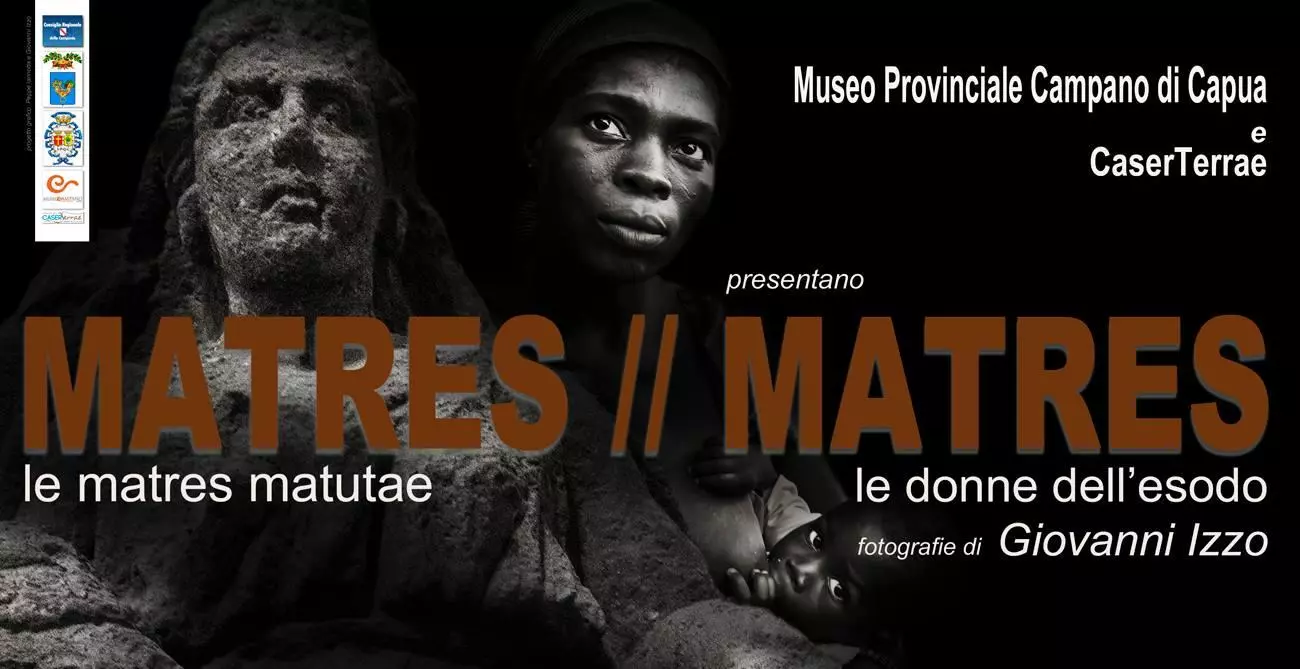Venue: Museo Provinciale Campano in Capua
Via Roma. Pal. Antigrano Capua (CE)
November 23, 2014 Opening / Closing 02/12/2014
Vernissage: 11.23.2014 h.11.00
Artist: Giovanni Izzo
Curator: Matteo De Simone
Concept and Design: Marinella Giuliano
Organization: Department of the Museum of Campania and the association CaserTerrae
On November 23, at 11.00, at the hall of the Matres Matutae the Provincial Museum Campano, the Directorate of Museum of Campania and the association CaserTerrae inaugurated the Photo Exhibition Matres // Matres photographer John Izzo.
For the first time the prestigious and unique collection to the world of tufa statues, Matres Matutae meets the work of contemporary artists: Matres - Women of the Exodus by John Izzo
Speakers at the opening on the. Max Bray, Raffaele Cutillo- architect, Matteo De Simone Curator Exhibition-psychoanalyst ordinary resp. Italian Cultural Association of Psychoanalysis (AIPsi).
Recommend Aprovidolo readings.
The realization of an exhibition as Matres // Matres at the Museo Campano to a receiver is a source of great joy to be able to connect the profound beauty of the Matres Matutae the Matres Izzo is an artistic and cultural heritage of great importance that assumes a international value. The levels "pathic" in spite of the common era and the different context deeply moved and at the same time give back hope and confidence in the continuity of life and mankind with all its deposits and cultural memories. The celebration of the Nativity, the primary creative experience, consecrated the genesis of humanity not only in procreation but in the very idea that the whole world can be thought and lived creatively. Matres Matutae, works extraordinarily beautiful, expressing thanks for the request and the fertility of the earth and motherhood, that is, the ability to have a future, this same hope to find in the Matres black Izzo, icons of the same feel. Matres: Women exodus images of women who are forced to leave their native land to poverty, persecution, to escape the genocide, thus suffering a break in the continuity of existence, they tell of their ability, through pregnancy and the birth of a son, to recreate themselves and their lives, cultivating and sowing hope for a different future. They are photos that have an absolute lightness, communicate deep emotions, the intensity of the mother-child dyad fundamental matrix of all things. The lights reminiscent of Caravaggio's eyes light up with promise, the children look at the future, and can fantasize about having found their land, the primitive is the mother's body, which is the same for everyone. In the picture we can see a fundamental Matres, according to the psychoanalyst Donald Winnicott, reciprocity between mother and child that is the reflection of the self of the child in the mother, which begins when the baby is newborn, the mother, looking at the child, and seeing in it a whole person, refer to this same child. The arms of the mother, then, keep the newborn's body in a state of unity and strength that allows him to feel supported by the mother's body, safe for close contact with the skin of the mother and the people in his environment around him. The representation of the rise of the child and his first step into the world, that hesitates and dance at the same time, with a rhythm that originates from the motions of his spirit, his imagination and sensibility, from his first nomination and sounds to the world and existence, the first poetic language, has often been represented and portrayed in art: primitive art, from the cycle of birth, up to Brancusi, Picasso, Carra, Klee and Dubuffet, who found art "original "recovering gestures and expression, body language and the dream of childhood. Izzo told several chicks of birth: the discovery of an identity of these women on the run through the primary creative form, that of children conceived and desired as a witness to a future guard inside if the distant past, a new opportunity to live and breathe in the land of the Exodus. These photos are reminiscent of the iconography of the Nativity, where the birth of the child redeems all mankind, those women who have been traveling and paths of pain, find a majestic at the same time simple and absolute in their primary express his creativity: the absolute beauty. John Izzo is a leading Italian photographers: his photography is impressive, humane, gentle, compassionate, but at the same time does not give truce, the photographer questions and try to tell the human. His photographs are a chorus of dreams, disappointments, anger, happiness, surprise, tears and joy. His work is driven by passion, compassion and mercy. It 'a human look that does not offend, but split up. His is a human look that exudes and breathe the possibility of hope. A hope for change, for a union of peoples and cultures, peoples and migrants who were once Italians now Africans.
 Share / Save
Share / Save






Comments 0
Say something